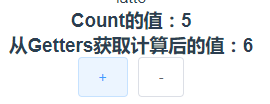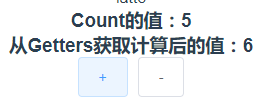1、安装vuex依赖包
npm install vuex --save
2、导入vuex包
import Vuex from 'vuex'
Vue.use(Vuex)
3、创建 store 对象
export default new Vuex.Store({ // state 中存放的就是全局共享的数据 state: { count: 0 } })
4、将 store 对象挂载到 vue 实例中
new Vue({ el: '#app', render: h => h(App), router, // 将创建的共享数据对象,挂载到 Vue 实例中 // 所有的组件,就可以直接用 store 中获取全局的数据了 store })
VueX:状态管理
Vuex 是一个专为 Vue.js 应用程序开发的状态管理模式。它采用集中式存储管理应用的所有组件的状态,并以相应的规则保证状态以一种可预测的方式发生变化。
核心模块:State、Getters、Mutations、Actions、Module
(1)、State:
// 创建store数据源,提供唯一公共数据 const store = new Vuex.Store({ state: { count: 0 } })
组件访问 Store 中数据的第一种方式:
this.$store.state.全局数据名称
组件访问 Store 中数据的第二种方式:
// 1.从 vuex 中按需导入 mapState 函数 import { mapState } from 'vuex'
通过刚才导入的 mapState 函数,将当前组件需要的全局数据,映射为当前组件的 computed 计算属性:
// 2.将全局数据,映射为当前组件的计算属性 computed: { ...mapState(['count']) }
(2)、Getters:
Getter相当于vue中的computed计算属性,不会修改 state 里的源数据,只起到一个包装器的作用,将 state 里的数据变一种形式然后返回出来。getter 的返回值会根据它的依赖被缓存起来,且只有当它的依赖值发生了改变才会被重新计算,这里我们可以通过定义vuex的Getter来获取,Getters 可以用于监听、state中的值的变化,返回计算后的结果。
① Getter 可以对 Store 中已有的数据加工处理之后形成新的数据,类似Vue的计算属性。
② Store 中数据发生变化,Getter 包装出来的数据也会跟着变化。
定义:
// 定义 Getter const store = new Vuex.Store({ state: { count: 0 }, getters: { showNum: state => { return '当前最新的数量是【'+ state.count +'】' } } })
使用 getters 的第一种方式:
this.$store.getters.名称
使用 getters 的第二种方式:
import { mapGetters } from 'vuex'
computed: {
...mapGetters(['showNum'])
}
(3)、Mutations:
更改 Vuex 的 store 中的状态的唯一方法是提交 mutation,只有 mutation 里的函数才有权利去修改 state 中的数据。Vuex 中的 mutation 非常类似于事件:每个 mutation 都有一个字符串的 事件类型 (type) 和 一个 回调函数 (handler)。但是,mutation只允许同步函数,不能写异步的代码。
①只能通过 mutation 变更 Store 数据,不可以直接操作 Store 中的数据。
②通过这种方式虽然操作起来稍微繁琐一些,但是可以集中监控所有数据的变化。
定义:
// 定义 Mutation const store = new Vuex.Store({ state: { count: 0 }, mutations: { add (state) { // 变更状态 state.count++ } } })
第一种触发方式:
// 触发 mutation methods: { handleAdd () { // 触发 mutations 的第一种方式 this.$store.commit('add') } }
还可以在触发 mutations 时传递参数:
// 定义 Mutation const store = new Vuex.Store({ state: { count: 0 }, mutations: { addN (state, step) { // 变更状态 state.count += step } } })
第一种触发方式:
// 触发 mutation methods: { handleAdd () { this.$store.commit('addN', 3) } }
触发 mutations 的第二种方式:
// 1.从 vuex 中按需导入 mapMutations 函数 import { mapMutations } from 'vuex'
通过刚才导入的 mapMutations 函数,将需要的 mutations 函数,映射为当前组件的 methods 方法:
// 2.将指定的 mutations 函数,映射为当前组件的methods 函数: methods: { ...mapMutations({'add', 'addN'}) }
注意:不要在 mutations 函数中,执行异步操作。所以就需要用到了 Action 用于处理异步任务。
(4)、Actions:
官方并不建议我们直接去修改store里面的值,而是让我们去提交一个actions,在actions中提交mutation再去修改状态值。可以异步操作。
Action 类似于 mutation,不同在于:
- Action 提交的是 mutation,而不是直接变更状态。
- Action 可以包含任意异步操作。
定义:
// 定义 Action const store = new Vuex.Store({ // ...省略其他代码 mutations: { add (state) { state.count++ } }, actions: { addAsync (context) { setTimeout(() => { context.commit('add') }, 1000) } } })
第一种方式触发:
// 触发 Action methods: { handleAdd () { // 触发 actions 的第一种方式 this.$store.dispatch('addAsync') } }
注意:在 actions 中,不能直接修改 state 中的数据,必须通过 context.commit() 触发某个 mutations 的函数才行。
触发 actions 异步任务时携带参数:
定义:
// 定义 Action const store = new Vuex.Store({ // ...省略其他代码 mutations: { addN (state, step) { state.count += step }, }, actions: { addNAsync (context, step) { setTimeout(() => { context.commit('addN', step) }, 1000) } } })
触发:
// 触发 Action methods: { handleAdd () { // 在调用 dispatch 函数,触发 actions 时携带参数 this.$store.dispatch('addNAsync', 5) } }
触发 actions 的第二种方式:
// 1.从 vuex 中按需导入 mapActions 函数 import { mapActions } from 'vuex'
通过刚才导入的 mapActions 函数,将需要的 actions 函数,映射为当前组件的 methods 方法:
// 2.将指定的 actions 函数,映射为当前组件的 methods 函数 methods: { ...mapActions(['addAsync', 'addNAsync']) }
(5)、Module
Vuex 允许我们将store 分割成模块(module)。每个模块拥有自己的 state、mutation、action、getter、甚至是嵌套子模块——从上至下进行同样方式的分割。
简要介绍各模块在流程中的功能:
- Vue Components:Vue 组件。HTML 页面上,负责接收用户操作等交互行为,执行 dispatch 方法触发对应 action 进行回应。
- dispatch:操作行为触发方法,是唯一能执行 action 的方法。
- actions:操作行为处理模块,由组件中的
$store.dispatch('action 名称', data1)来触发。然后由 commit()来触发 mutation 的调用 , 间接更新 state。负责处理 Vue Components 接收到的所有交互行为。包含同步/异步操作,支持多个同名方法,按照注册的顺序依次触发。向后台 API 请求的操作就在这个模块中进行,包括触发其他 action 以及提交 mutation 的操作。该模块提供了 Promise 的封装,以支持 action 的链式触发。 - commit:状态改变提交操作方法。对 mutation 进行提交,是唯一能执行 mutation 的方法。
- mutations:状态改变操作方法,由 actions 中的
commit('mutation 名称')来触发。是 Vuex 修改 state 的唯一推荐方法。该方法只能进行同步操作,且方法名只能全局唯一。操作之中会有一些 hook 暴露出来,以进行 state 的监控等。 - state:页面状态管理容器对象。集中存储 Vue components 中 data 对象的零散数据,全局唯一,以进行统一的状态管理。页面显示所需的数据从该对象中进行读取,利用 Vue 的细粒度数据响应机制来进行高效的状态更新。
- getters:state 对象读取方法。图中没有单独列出该模块,应该被包含在了 render 中,Vue Components 通过该方法读取全局 state 对象。
下面写个简单的小实例,方便大家理解VueX:
1、首先在store/index.js里定义state:
state: { Count: 0 //数值 },
2、新建一个test.vue文件:
<template> <div> <h3>Count的值:{{this.$store.state.Count}}</h3> </div> </template>
这时候运行,页面上就得到了这个count值为0。
3、在store/index.js里通过getters新建getStateCount方法接收一个参数state,这个参数就是我们用来保存数据的那个对象Count;
getters: { getStateCount(state) { return state.Count + 1; //返回Count值 } }
4、修改test.vue文件
<template> <div> <h3>Count的值:{{this.$store.state.Count}}</h3> <h3>从Getters获取计算后的值:{{this.$store.getters.getStateCount}}</h3> </div> </template>
这时在页面显示:

5、在页面下面添加2个按钮,分别可以增加1、减少1:
修改test.vue页面:
<template> <div> <h3>Count的值:{{this.$store.state.Count}}</h3> <h3>从Getters获取计算后的值:{{this.$store.getters.getStateCount}}</h3> <div> <button @click="addCount">+</button> <button @click="delCount">-</button> </div> </div> </template> <script> export default { methods: { addCount:function(){ this.$store.commit("changAdd"); }, delCount:function(){ this.$store.commit("changDel"); }, } } </script>
6、因为修改store中的值唯一的方法就是提交mutation来修改,所以在store/index.js里添加mutations,在mutations中定义两个函数,用来对count加1和减1
mutations: { changAdd(state) { state.Count = state.Count + 1; }, changDel(state) { state.Count = state.Count - 1; } },
这时可以在页面上点击+、- 按钮操作数据:

小bug:Count到0的时候点击-还可以减1为-1,所以修改下代码:
changDel(state) { if (state.Count == 0) return; state.Count = state.Count - 1; }
OK,现在可以完美实现功能。
但是,官方并不建议我们这样直接去修改store里面的值,而是让我们去提交一个actions,在actions中提交mutation再去修改状态值,接下来我们修改store/index.js文件
7、先定义actions提交mutation的函数:
actions: { changAddCount(content) { content.commit("changAdd"); }, changDelCount(content) { content.commit("changDel"); } }
8、然后我们去修改test.vue文件:
methods: { addCount:function(){ //this.$store.commit("changAdd"); this.$store.dispatch("changAddCount") }, delCount:function(){ //this.$store.commit("changDel"); this.$store.dispatch("changDelCount") }, }
这里我们把commit提交mutations修改为使用dispatch来提交actions;现在我们点击页面,效果是一样的。

好了,我们这里已经实现了一个基本的vuex修改状态值的完整流程。如果我们需要指定加减的数值,那么我们直接传入dispatch中的第二个参数,然后在actions中的对应函数中接受参数在传递给mutations中的函数进行计算:
9、修改mutations和actions:
mutations: { changAdd(state) { state.Count = state.Count + 1; }, changDel(state, n) { if (state.Count == 0) return; state.Count = state.Count - n; } }, actions: { changAddCount(content) { content.commit("changAdd"); }, changDelCount(content, n) { content.commit("changDel", n); } }
10、修改test.vue页面:
methods: { addCount:function(){ //this.$store.commit("changAdd"); this.$store.dispatch("changAddCount") }, delCount:function(){ //this.$store.commit("changDel"); var n = 2; this.$store.dispatch("changDelCount", n) }, }
这个时候我们再去点击“ - ”按钮就会发现不再是减1了,而是减去2了。

这次到1的时候会减为-1,继续修改:
changDel(state, n) { if (state.Count == 0) { return; } else if (state.Count == 1) { state.Count = state.Count - 1; } else { state.Count = state.Count - n; } }
OK,功能实现了,最终减到0为止。
辅助函数mapState:
当一个组件需要获取多个状态时候,将这些状态都声明为计算属性会有些重复和冗余。为了解决这个问题,我们可以使用 mapState 辅助函数帮助我们生成计算属性,让你少按几次键。
首先要在页面中构建:
<!-- <h3>Count的值:{{this.$store.state.Count}}</h3> --> <h3>Count的值:{{Count}}</h3> <script> //在单独构建的版本中辅助函数为 Vuex.mapState import { mapState } from 'vuex' //当然也可以一起构建 import {mapState, mapMutations, mapActions, mapGetters} from 'vuex'; export default { computed: mapState({ // 箭头函数可使代码更简练 Count: state => state.Count, }) } </script>
对象展开运算符:可以简化写法
<!-- <h3>Count的值:{{this.$store.state.Count}}</h3> --> <h3>Count的值:{{Count}}</h3> <script> import {mapState, mapMutations, mapActions, mapGetters} from 'vuex'; export default { computed: { //计算属性 ...mapState(['Count']), //用...展开运算符把Count展开在资源属性里 }, }; </script>
效果当然是一样的。
<h3>Count的值:{{Count}}</h3> <h3>从Getters获取计算后的值:{{getStateCount}}</h3> <script> import {mapState, mapMutations, mapActions, mapGetters} from 'vuex'; export default { computed: { //计算属性 ...mapState(['Count']), ...mapGetters(['getStateCount']), }, methods: { ...mapMutations(['changAdd','changDel']), ...mapActions({ addCount: 'changAddCount', }), delCount:function(){ var n = 2; this.changDelCount(n); }, ...mapActions({ changDelCount: "changDelCount", }), } }; </script>